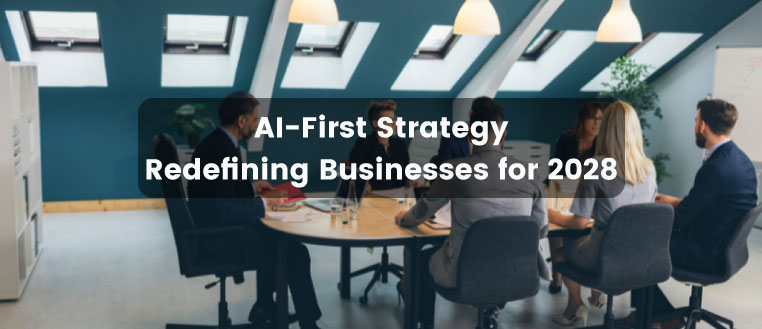Artificial intelligence is no longer a supporting capability — it has become a central driver of business performance and competitiveness.
According to Gartner, by 2028, organisations that adopt and sustain an AI-first strategy will achieve 25% better business outcomes than those that do not.
An AI-first approach does not mean deploying AI in every process or product. Rather, it represents a disciplined shift in thinking — one where AI is considered a primary option for every strategic decision and investment, and applied only where it can deliver measurable value.
This perspective marks a decisive evolution from selective experimentation to structured integration, positioning AI as an enabler of sustained business transformation rather than a collection of isolated initiatives.
What an AI-First Strategy Really Means
An AI-first strategy positions artificial intelligence as a core consideration in every business decision and investment, rather than an optional enhancement.
Gartner distinguishes between being AI-first and being AI-always.
“An AI-first organisation explores where AI can deliver genuine business value, while an AI-always approach applies it indiscriminately, often leading to inefficiencies or poor alignment with strategic goals.”
Adopting an AI-first mindset means shifting from asking “Where can we use AI?” to “How can AI improve this decision, process, or outcome?”
It is a disciplined approach that prioritises impact and relevance over ubiquity, ensuring AI serves as a driver of business performance — not as a technology trend to follow.
When to Adopt an AI-First Approach
- Unrealised Potential: When the gap between expected and actual outcomes widens for AI initiatives, it signals a need for a more integrated, strategic approach.
- Structural and Cultural Barriers: Outdated systems, rigid processes, or resistant mindsets often limit AI’s ability to drive large-scale transformation. These barriers signal that incremental improvements are no longer sufficient.
- Industry Disruption: In sectors undergoing rapid change, AI can redefine market leadership. High exposure to disruption makes an AI-first strategy critical for maintaining competitiveness.
- Leadership Readiness: When executive leadership is aligned and committed to transformation, but the organisation lacks the structure or capability to execute, an AI-first approach provides the necessary framework for scaling adoption.
Setting the Scope of Your AI-First Strategy
Gartner identifies multiple ways organisations can apply an AI-first approach, depending on their maturity, resources, and strategic priorities. Selecting the right scope determines both the pace and scale of transformation.
- Enterprise-Wide: A holistic approach that embeds AI across all business functions and operating models. It is typically CEO-driven, demanding organisation-wide commitment and coordination.
- Product-Level: At this level, AI becomes integral to product design and development. This approach is well-suited to digital-native and technology-focused enterprises where innovation cycles are fast and data is a core asset.
- IT-Level: Focused on modernising infrastructure and operations, this scope enhances efficiency in the design, integration, and management of technology systems. It enables a foundation for future AI expansion across the organisation.
- Function-Specific: Applicable to individual business areas such as R&D, production, engineering, or supply chain, where readiness and data availability are higher. It enables measurable progress without disrupting a full-scale transformation.
Managing the Transition – The Short-Term Disruption Trap
Gartner cautions that organisations adopting an AI-first strategy may experience temporary performance setbacks as they navigate maturity gaps in technology, skills, and processes.
This period of adjustment is not a sign of failure but a predictable phase in transformation. Effective leadership plays a critical role in managing this transition.
Transparent communication, clear expectations, and consistent reinforcement of long-term goals help maintain alignment across teams.
Equally important is a strong change management framework — one that prioritises employee engagement through retraining, reskilling, and open dialogue about the benefits and safeguards of AI.
The Long-Term Payoff – A Call to Leadership
Gartner projects that by 2028, organisations that sustain an AI-first strategy will achieve up to 25% better business outcomes than their competitors.
AI-first is not simply a technological shift — it represents a strategic philosophy of ongoing discovery and improvement.
For leadership, this marks a defining moment. Between 2025 and 2028, the competitive landscape will increasingly favour organisations that embed AI into the core of their business model. CEOs and executive teams must lead this transformation by defining the right scope, preparing their culture, and championing the change from the top.
Those who act decisively today will set the benchmark for performance in the years ahead.
Partnering with NexaQuanta for an AI-First Transformation
Successfully implementing an AI-first strategy requires not only vision and leadership but also expertise in safe, responsible, and scalable AI adoption.
NexaQuanta partners with organisations to navigate this transformation, providing solutions that align AI initiatives with strategic goals while mitigating risk.
Our approach ensures that AI delivers measurable value, accelerates learning, and strengthens resilience — helping executives move from planning to execution with confidence.

